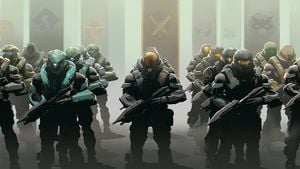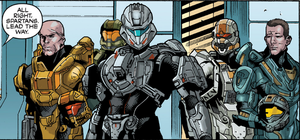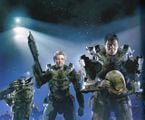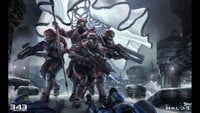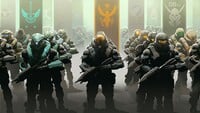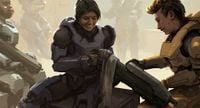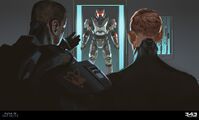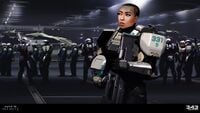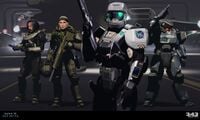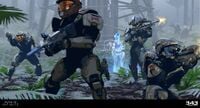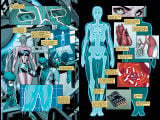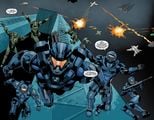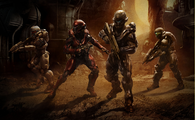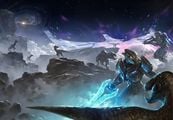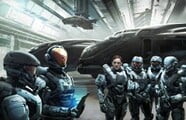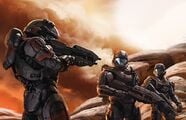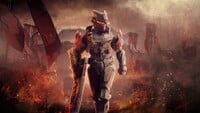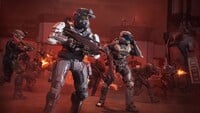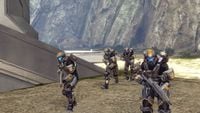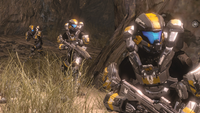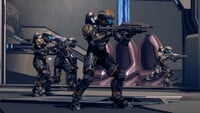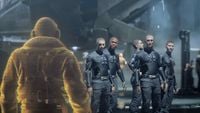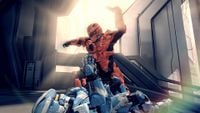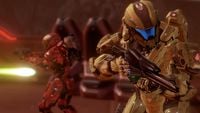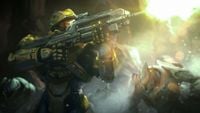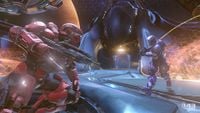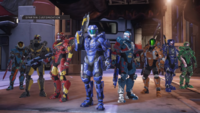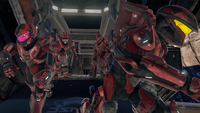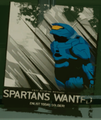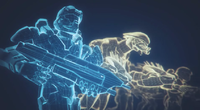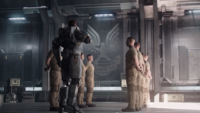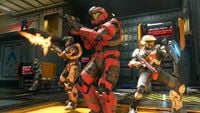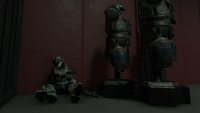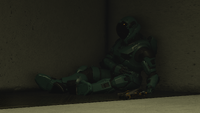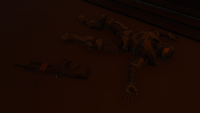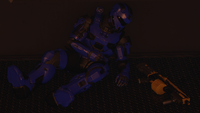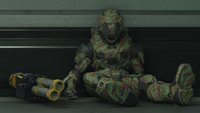SPARTAN-IV program
From Halopedia, the Halo wiki
| SPARTAN-IV program | |
|---|---|
 The emblem of the Spartan-IVs | |
|
Active: |
|
|
Branch: |
|
|
Type: |
|
|
Size: |
300-500+ [3]
|
- "You are Spartans now. You stand side by side with your Spartan brothers and sisters. You march into battle together--you do not charge ahead. You do not grab glory for yourself. Spartans don't have rank because Spartan is your rank. You are naturally superior. We have made you better. You are Spartans now. Start acting like it."
- — Musa-096[4]
The SPARTAN-IV program is the fourth iteration of the SPARTAN supersoldier projects. Like the original ORION Project, the SPARTAN-IV program utilizes consenting adult volunteers selected from the other branches of the United Nations Space Command, in contrast to the previous two programs which used children as candidates.[5] Recruits are drawn from both career military veterans and young soldiers who show considerable promise.[6]
The physical augmentations of the Spartan-IV supersoldiers are significantly less extensive than those of the two preceding programs, although their standard-issue GEN2 Mjolnir armor is more technologically advanced, and designed to compensate for this drawback.[7][7][8] The Spartan-IVs serve in Spartan Operations, an independent branch of the United Nations Space Command armed forces created for the oversight of their operations.[9]
History
The SPARTAN-IV program has its roots between 2548 and 2550, when ONI began to experiment with adding limited enhancements to select groups of special operators.[1] After Victor Gallardo, Dorian Nguyen, Evelyn Rousseau and Saskia Nazari were exposed to the deadly effects of a Forerunner artifact, ONI offered them the chance to become part of the program, having discovered that Owen-B096's genetic enhancements as a Spartan-III made him immune to the same effects. With the dying Victor's parents having already agreed on his behalf, ONI started the augmentations before they told the other three which appeared to be working. After considering their options, the rest of the group agreed to undergo the augmentations and join the new program, both to survive and to continue fighting the Covenant.[10]
At some point prior to the instatement of the current SPARTAN-IV program in 2553,[2] elements within the Office of Naval Intelligence's Section III authorized a prototypical phase without approval from High Command. This incarnation was intended to produce supersoldiers whose physical prowess rendered MJOLNIR armor redundant. However, only one of the ten volunteer test subjects survived the augmentation process. The survivor, Ilsa Zane, was driven mad by the experience and was folded into ONI. Despite the project's failure, Zane was considered the original Spartan-IV.[11]
The program as it now exists was commissioned as a result of the success of the preceding SPARTAN-II and SPARTAN-III projects. The SPARTAN-IV project was conceived by Lieutenant Commander Musa-096, a former Spartan-II candidate who was crippled by the augmentation process. Despite his grudge toward Dr. Catherine Halsey, Musa recognized the crucial role of the Spartans in defending humanity and the continued importance of the supersoldiers in the aftermath of the Human-Covenant War.[12] The proposal was approved by Admiral Margaret Parangosky, then-Commander-in-Chief of the Office of Naval Intelligence, and the new program was initiated under her orders. Parangosky initially planned to have SPARTAN-III lead Colonel James Ackerson heading the program, with SPARTAN-II project lead Dr. Catherine Halsey to be reassigned as Ackerson's subordinate.[13] Ackerson was killed following the Battle of Mare Erythraeum and Halsey was arrested after returning from Onyx, though ONI continued the program without the two,[14] headed by Musa-096 and Jun-A266, a former SPARTAN-III Alpha Company member.[12]
The first class of Spartan-IVs, consisting of 145 members, went active on January 7, 2553.[2] Due to the success of the initial group, Commander Musa-096 was able to secure funding for a second class. Initiated in 2554, the second class was considerably larger than the first one due to the increased funding and was able to draw from a wider pool of candidates.[15]
Facilities and organization
The SPARTAN-IV program is headquartered at a dedicated facility on Mars. Their augmentation procedures are conducted at the same facility.[16] The compound is able to augment around a dozen or two Spartans at any given time.[17] Their training is primarily conducted in a top-secret space station orbiting an unidentified dwarf planet.[18]
Hundreds of Spartan-IVs are assigned to UNSC Infinity, the most powerful warship ever constructed by mankind.[14] The frigate UNSC Meriwether Lewis also has its own Spartan contingent.[19] Spartan-IVs train with one another in simulations known as "War Games" on Infinity's state-of-the art combat deck (a training chamber that is capable of replicating environments), in order to constantly stay battle-ready.[20] Spartan-IVs also train in multiple different forms of martial arts outside of the War Games simulator.[21] As per STO 11.6, Spartan daily training must include at least two hours of military occupational specialty training, and two hours of physical conditioning and augmentation monitoring. [22] Select Spartan-IIs have participated in the training of the Spartan-IVs.[23]
The Spartan-IVs serve in a dedicated branch of the UNSC known as Spartan Operations or "Spartans", whereas their forebears operated within other chains of command,[9] although some Spartan-IVs serve in more covert roles within ONI.[2] In addition to the significant numbers of adult volunteers which make up the majority of the Spartan-IVs, the Spartan-IIIs who survived the Human-Covenant War were offered to be integrated with the Spartan-IVs in the new Spartan branch.[24] Many of the remaining Spartan-IIIs were folded in with the Spartan-IVs in the new branch, while others resigned to noncombat roles.[25]
Personnel
Unlike their predecessors, the Spartan-IVs are identified by their surnames rather than numeric tags (due to their volunteered enlistment rather than conscription). The Spartan-IVs have shown a great deal of solidarity, especially impressive given the short time they have served together. Many of them have adopted colloquialisms first used by the Spartan-IIs, such as "Alpha Bravo" for "Alien Bastard". Psychologists assert that this camaraderie and cohesiveness will help distinguish the Spartan-IVs, and the Spartan branch as a whole, from the other UNSC branches.[6]
List of known SPARTAN-IV units and personnel
| Unit | Status | Personnel | Notes |
|---|---|---|---|
| UNSC Infinity Spartan command | Active |
|
|
| Gypsy Company | Active | At least two Spartan-IVs[27] | Also contains UNSC Marine Corps personnel.[27] |
| Mountain Squad | KIA |
|
A science attache unit; killed during the Requiem Campaign after being shot down in Two Giants.[28] |
| Alpha-Nine | Active | Disbanded as ODST Fireteam after Draco III rebellion in 2554. Reinstated as Spartan Fireteam after Battle of Cassidy III in 2558. | |
| Fireteam Apex | Active | unknown | Participated in the Requiem Campaign[29] |
| Fireteam Apollo | Active[30] | Participated in Operation: SHELL GAME, the Mission to the Korinth Prior system and the hunt for the Ace of Spades and 343 Guilty Spark | |
| Fireteam Avalanche | Active | unknown | Participated in the Requiem Campaign[31] |
| Fireteam Bailey | Active |
|
Participated in the Battle of Ealen IV |
| Fireteam Castle | KIA | Killed in action after being shot down during the Requiem Campaign[33] | |
| Fireteam Cerberus | Unknown | Four Spartan-IVs[34] | unknown |
| Fireteam Crimson | Active | Five Spartan-IVs | Participated in the Requiem Campaign[29] |
| Fireteam Colossus | Active | Four Spartan-IVs | Participated in the initial ambush in the Raid on Oth Lodon |
| Fireteam Dagger | Active | Four Spartan-IVs | unknown |
| Fireteam Domino | Active |
|
Participated in the Requiem Campaign[29] |
| Fireteam Eagle | Active | Five Spartan-IVs | unknown |
| Fireteam Fenrir | Active | unknown | Participated in the initial ambush during the Ambush at Oth Lodon |
| Fireteam Ferret | Unknown | unknown | unknown |
| Fireteam Forest | Active | Aided Crimson in acquiring replace power supply for the Harvester[35] | |
| Fireteam Grizzly | Unknown | unknown | unknown |
| Fireteam Hellhound | Unknown | unknown | unknown |
| Fireteam Horse | Active | unknown | Participated in the Requiem Campaign[29] |
| Fireteam Hydra | unknown | Four Spartan-IVs[36] | unknown |
| Fireteam Ivy | Active | unknown | Participated in the Requiem Campaign[29] |
| Fireteam Intrepid | Active | Participated in the Battle of New Mohács,[37] and the Battle for Installation 07[38] | |
| Fireteam Jackknife | Disbanded |
|
Participated in the Battle of Ealen IV; betrayed by Vladimir Scruggs, and Naiya Ray transferred to Fireteam Majestic |
| Fireteam Kodiak | Active | unknown | Participated in the Requiem Campaign[39] |
| Fireteam Lancer | Unknown |
|
Participated in the Requiem Campaign.[29] In 2559, the team participated in the Battle for Zeta Halo |
| Fireteam Leviathan | KIA | Four SPARTAN-IVs[40] | Wiped out during the Outbreak at Site 22.[40] |
| Fireteam Majestic | Active[29] |
|
Participated in the Requiem Campaign, the Ambush at Oth Lodon, Operation: WHISTLE STOP, and the Battle of Aktis IV |
| Fireteam Mako | Unknown | unknown | unknown |
| Fireteam Osiris | Active |
|
Participated in the battles of Kamchatka, Meridian, Nuusra, Sunaion, and Genesis. Were sent to retrieve John-117 and the rest of Blue Team after they were declared AWOL in 2558. Edward Buck subsequently left to reform Alpha-Nine. Jameson Locke was deployed on Operation: BREAKER TRIP in December 2559. |
| Fireteam Phoenix | Unknown | unknown | unknown |
| Fireteam Rhino | Active | Four Spartan-IVs | Participated in the Requiem Campaign[29] |
| Fireteam Shadow | Active | Participated in the Battle of Requiem and its campaign months after[29]. In 2559, the team participated in the Battle for Zeta Halo. | |
| Fireteam Stingray | Unknown |
|
Participated in Operation: OCEAN RAPTOR at a location "redacted" by the Office of Naval Intelligence.[19] |
| Fireteam Sword | Active | unknown | Participated in the Requiem Campaign[29] |
| Fireteam Switchback | Active |
|
Captured during a mission to destroy a Harvester during the Requiem Campaign[42] Later rescued by Fireteam Crimson and Fireteam Lancer.[43] |
| Fireteam Sydney | Active | unknown | Participated in the Requiem Campaign[29] |
| Fireteam Talon | Active | unknown | Participated in the Requiem Campaign[29] |
| Fireteam Taurus | Unknown |
|
Participated in Battle of New Mohács[37] and the Battle for Installation 07[38] |
| Fireteam Tower | Active | unknown | Participated in the Requiem Campaign[29] |
| Fireteam Venom | Active | Five Spartan-IVs | unknown |
| Fireteam Windfall | Active |
|
Participated in the Battle for Installation 07[38] |
| Fireteam Wolf | Active | unknown | Participated in the Requiem Campaign[29] |
- Unknown units
- Adrian Vesco
- Babych
- Bethany Kossup
- Dorian Nguyen
- Edward Davis - KIA during the Battle of Draetheus V
- Elias Holt
- Evelyn Rousseau
- Frank Kodiak
- Hideo Wakahisa - KIA
- Hieu Dinh
- Jengo Farouk
- Joel Thomas
- Kovsky
- Laurette Agryna
- M. Jaide
- Natalie Kenzo
- Orzel
- Panago - KIA during the Battle for Installation 07
- Prentis
- Rosado
- Rudolf Schein - Formerly; defected to the United Rebel Front. KIA
- Sarkar - KIA during the Battle for Installation 07
- Saskia Nazari
- Sigrid Eklund
- Sinclair - KIA during the Battle of Nysa
- Theodore Sorel - KIA
- Yeong-hao Holst
- Victor Gallardo
- Vinay Sahil
- Unidentified Spartan
- Unidentified Spartan-IV headhunter - KIA in 2559 after being captured by their target, Inka 'Saham
- Multiple Spartans killed by Gek 'Lhar
- Seventy-six Spartans killed by Leonidas in the destruction of Laconia Station
- Two Spartans killed by Ilsa Zane
Discharged
Ten Spartan-IV candidates were discharged from the prototypical phase of the program after being crippled or killed by the augmentations.[11]
- Ilsa Zane - Discharged after her augmentations left her mentally unstable and assigned to the Office of Naval Intelligence; subsequently escaped and defected to the New Colonial Alliance.[11]
Equipment

MJOLNIR armor
- Main article: MJOLNIR Powered Assault Armor (GEN2)
Spartan-IVs are equipped with the MJOLNIR [GEN2], the second-generation version of the MJOLNIR Powered Assault Armor.[20] Because of the Spartan-IVs' less extensive biological augmentations, the GEN2 armor boosts its wearer's reactions, speed, and strength to a greater degree than the first-generation Mjolnir.[7]
An assortment of armor configurations are available for all new Spartans per UNSC Regulation 3A-950, and Spartans are capable of customizing their individual armor set with modular components from a wide range of special-purpose variants, based on their personal preferences, specialization, and mission requirements. Selecting variants for purely cosmetic reasons is discouraged. It is strictly forbidden for Spartans to attempt to repair or modify their armor; all armor maintenance is only to be performed by qualified Class-61 technicians in dedicated facilities.[44] Unlike the generally green coloration of the Spartan-IIs' Mjolnir armor, Spartan-IV armor comes in a profusion of distinct color patterns, with the members of specific teams often sporting a consistent coloration.[45] However, any customization of the armor color must be in accordance to UNSC Equipment Code 20.00.62.[44]
The standard-issue armor set for Spartan-IV (at least those assigned to UNSC Infinity) is the Recruit variant,[46] colored gray and gold.[47][45] Spartan-IVs also have access to more specialized equipment depending on their missions, example being the Infinity Actual Kit, and Forerunner Hybrid Kit.
Augmentation procedures
- Main article: Project ORCHID
Like the augmentations performed for the Spartan-IIs and the improved procedures utilized in the subsequent SPARTAN-III program, the Spartan-IVs undergo a series of procedures to enhance their physical capabilities and to wear Mjolnir powered armor.[9] The technology used in the two preceding SPARTAN programs necessitated that the candidates meet exceedingly strict genetic qualifications as well as the application of the enhancements on preteens, to avoid the catastrophic failure rates produced by the augmentation of adult subjects in the ORION Project.[48] By the time of the initiation of the SPARTAN-IV program, the technology had advanced to the point that adults could be augmented without major risk,[49] although the improvements to the subject's strength and speed are not as extensive as in the previous two programs.[7][50] The genetic enhancements were similar to the ones in the Spartan-III augmentations and were believed to be the only possible treatment against deadly genetic damage caused by a Forerunner artifact on Meridian, the Spartan-III augmentations having rendered Owen-B096 immune to the same issue.[10]
Gallery
Concept art
Concept art of Spartan-IVs for Halo 4.
Concept art of Spartan-IVs competing in a Breakout match for Halo 5: Guardians.
Concept art of Spartan-IVs in a match of Capture the Flag for Halo 5: Guardians.
Alternate art of Spartan-IVs for the Halo: Official Spartan Field Manual.
Concept art for Halo Infinite of a Spartan-IV receiving their armor.
Illustrations and renders
A Spartan-IV from Making Halo 4: First Look.
Sarah Palmer undergoing her augmentation procedures in Halo: Initiation.
Fireteam Majestic and other Spartan-IVs in Halo: Escalation.
Fireteam Apollo in training.
Jameson Locke's Spartan team, Fireteam Osiris.
Spartan-IV Frank Kodiak and Shipmaster N'tho 'Sraom fighting blind wolves on Installation 00 during Operation: FAR STORM in Halo: Hunters in the Dark.
Spartan-IVs in Halo Mythos.
Alpha-Nine as Spartan-IVs.
Spartans Bonita Stone and Nina Kovan on Zeta Halo.
Spartan-IVs during the Battle of Nysa.
Screenshots
A Spartan-IV wearing Recruit armor in Halo 4.
Mountain Squad in RECRUIT-class armor during the Requiem Campaign.
Fireteam Lancer during the Requiem Campaign.
Fireteams Lancer and Switchback during the Requiem Campaign.
Fireteam Shadow during the Requiem Campaign.
Fireteam Majestic observing the AI Roland's avatar in Spartan Ops.
Gabriel Thorne donning his RECRUIT-class helmet.
Edward Davis during the Battle of Draetheus V in Halo: Spartan Assault.
A human child holding a Spartan-IV action figure painted to resemble the Master Chief in A Hero Falls.
Spartans Locke and Tanaka in The Hunt Begins.
Spartan-IVs facing off in the War Games simulator in Halo 5: Guardians.
Spartan-IVs in October, 2558.
Spartan-IVs disembarking from a D79H Pelican during a Warzone simulation.
Spartan-IVs and Sangheili in the War Games simulator aboard Anvil Station in Halo Online.
Spartan-IVs in a War Games simulation on Recharge.
A Spartan-IV who perished during the Battle of Nysa.
List of appearances
Sources
- ^ a b Halo: Official Spartan Field Manual, page 87
- ^ a b c d Halo Waypoint - Spartans
- ^ a b YouTube: Halo 4 Flag Stabbing and Spartan Cosplay - Comic-Con 2012
- ^ Halo: Initiation, issue 2
- ^ Halo: Glasslands, page 434
- ^ a b Eleventh Hour reports, part 3
- ^ a b c d Frank O'Connor interview during San Diego Comic-Con 2012 1:15 - 2:10
- ^ Halo 5: Guardians – Unmasking The Fireteam Hunting Master Chief
- ^ a b c Halo 4 Official Site: Story
- ^ a b Halo: Meridian Divide, chapter 21
- ^ a b c Halo: Initiation, issue 3
- ^ a b Halo: Initiation, issue 1
- ^ Halo: Glasslands, page 147
- ^ a b Halo: Glasslands, page 422
- ^ Halo: New Blood, page 106 (Google Play edition)
- ^ Halo: New Blood, pages 113, 126, 174 (Google Play edition)
- ^ Halo: New Blood, page 115 (Google Play edition)
- ^ Halo: New Blood, page 122 (Google Play edition)
- ^ a b Halo 5: Guardians Limited Edition, Spartan Locke's Classified Orders
- ^ a b Gameinformer (May 2012), pages 46-47
- ^ Image showing Thorne, Madsen, and other Spartan-IVs sparring in different forms of MMA.
- ^ Halo Legendary Crate, Data Drop #1
- ^ Halo Waypoint: Spartans
- ^ Halo: Glasslands, page 435
- ^ Halo Waypoint: Catalog Interaction - Page 14
- ^ a b YouTube - Halo 4: Spartan Ops Gameplay
- ^ a b Halo 4, campaign level Reclaimer
- ^ a b c d Halo 4 - Spartan Ops, episode Catherine, level Spartan Mountain
- ^ a b c d e f g h i j k l m n o p q r s Halo 4 Limited Edition — War Games Session Summary
- ^ a b Halo Legendary Crate Available for Order; Become a Member of Fireteam Apollo
- ^ Halo 4 - Spartan Ops, episode Invasion, level Home Field
- ^ Halo 4 - Spartan Ops, episode Departure
- ^ Halo 4 - Spartan Ops, episode Didact's Hand, level Hairy Call
- ^ Halo: Flashpoint, Fireteam Cerberus Pack (Retrieved on Oct 3, 2024) [archive]
- ^ Halo 4 - Spartan Ops, episode Exodus, level Seize the Power
- ^ Halo: Flashpoint, Fireteam Hydra Pack (Retrieved on Oct 3, 2024) [archive]
- ^ a b Halo: Shadows of Reach, chapter 16
- ^ a b c Halo Infinite
- ^ Halo 4 - Spartan Ops, episode Invasion, level The Guns of Infinity
- ^ a b Halo: Saturn Devouring His Son
- ^ MightyApe.co.nz: Halo 4 Limited Edition screenshots
- ^ YouTube - Halo 4: Spartan Ops - Episode 6 Chapter 4 Developer Commentary
- ^ Halo 4 - Spartan Ops, episode Expendable, level Lancer
- ^ a b Halo 4 Limited Edition - Infinity Briefing Packet
- ^ a b Halo 4 - Spartan Ops
- ^ Halo 4: Recruit armor description
- ^ Halo 4, campaign level Infinity
- ^ [Dr. Halsey's personal journal
- ^ Halo: New Blood, page 52 (Google Play edition)
- ^ Halo: New Blood, page 113 (Google Play edition)
| |||||||||||||||||
